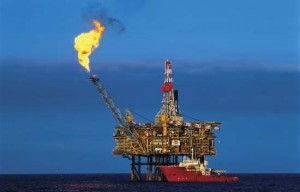 Both West Texas Intermediate and Brent crude benchmarks fell on Monday after a deal between rebels and Libya’s central government paved the way for the reopening of four exports terminals. Losses however were capped by stronger demand outlook in the US after Friday’s robust employment data, coupled with persistent geopolitical tensions between Russia and the West. Meanwhile, natural gas futures advanced amid forecasts for unseasonably cold weather in the US.
Both West Texas Intermediate and Brent crude benchmarks fell on Monday after a deal between rebels and Libya’s central government paved the way for the reopening of four exports terminals. Losses however were capped by stronger demand outlook in the US after Friday’s robust employment data, coupled with persistent geopolitical tensions between Russia and the West. Meanwhile, natural gas futures advanced amid forecasts for unseasonably cold weather in the US.
On the New York Mercantile Exchange, WTI crude for delivery in May traded at $101.07 per barrel at 14:07 GMT, down 0.1% on the day. Prices shifted in a daily range between $100.22 and $101.08 per barrel. The US contract jumped by 0.85% on Friday but settled the week 0.6% lower, the first decline in three weeks.
Meanwhile on the ICE, Brent futures for settlement in the same month slid 0.37% to $106.35 per barrel, having varied between day’s high and low of $106.40 and $105.25 per barrel respectively. The European crude benchmark rose by 0.5% on Friday but closed the week 1.3% lower. Brent traded at a premium of $5.13 to its US counterpart, down from Friday’s settlement at $5.58. The gap narrowed to $5.17 on Wednesday, the smallest since October 2nd.
The self-declared Executive Office for Barqa, the rebel name of the eastern region of Cyrenaica, has agreed to hand over control of two of the four oil ports under its control to the central government immediately, bringing back online a capacity of around 180 000 barrels per day.
According to Sunday’s deal, Libya’s Zueitina and Hariga ports will reopen immediately, while the larger ports, Ras Lanuf and Es Sider, will be surrendered within the next two to four weeks after more negotiations. Es Sider, the country’s largest port, has a daily capacity of 340 000 bpd, while Ras Lanuf can ship 220 000 barrels per day.
However, robust employment data released by the Labor Department on Friday added to previous signs that the recent economic slowdown in the US due to inclement winter weather has been overcome.
US private job growth exceeded its pre-recession peak for the first time. Despite supporting Fed’s view to further cut its Quantitative Easing program, the data fanned positive sentiment for fuel demand in the world’s top consumer.
The oil complex was also underpinned by simmering tensions between Russia and the West. Pro-Russian protesters gained control over state buildings in three eastern Ukrainian cities on Sunday. Kiev’s pro-European government accused Russian President Vladimir Putin of fueling separatist disorder.
Meanwhile, on the New York Mercantile Exchange, natural gas for delivery in May traded at $4.480 per million British thermal units at 14:08 GMT, up 0.91% on the day. Prices held in a daily range between $4.527, and $4.446 per mBtu. The energy source slid 1.4% last week, despite a government report showed much-larger-than the five-year average inventory drop.
Cold blasts will return in the US around April 13-17th, as chilly Canadian air moves back in the US territory, bringing significant surge in natural gas and heating demand, NatGasWeather.com reported today.





